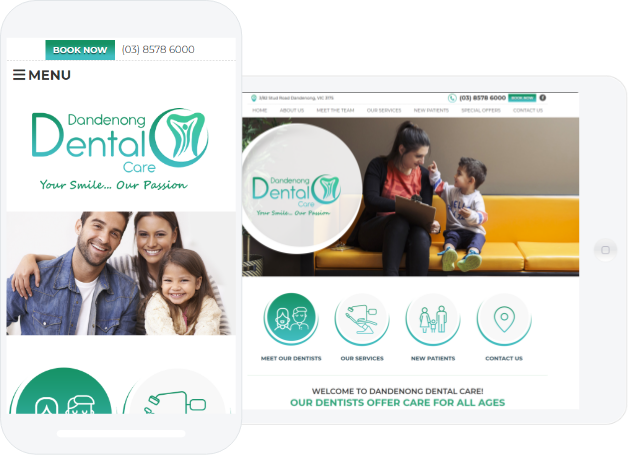As a dentist, you view yourself as a “dental practice.” You practice the art of medicine, serving people to keep their mouths healthy and smiles bright.
You don’t refer to those you serve as “customers” or “clients.” They’re patients.
However, the reality is you are a small business that has the same demands as an accountant, a mattress store, or an online retailer. To survive, you must get and keep more new customers.
f
Unless you’ve taken business classes, this probably wasn’t in your educational curriculum. You were trained to think like a doctor, not a business owner.
But if you’re going to build a thriving practice (and sustain it over the long-term), it’s time to start looking at yourself as both a practice and a business.
Successful businesses usually have strong, memorable brands. Branding isn’t a concept reserved for companies like Coca-Cola and their latest advertising campaign. It’s a need of large businesses and small businesses alike. Your dental brand tells patients what to expect before visiting your practice. It’s that emotional impression left on patients before you meet them and after they visit you.
Without a solid brand, you’re a business without an identity, just another forgettable dental practice. You’re also missing a key business asset – one that will add to your patient roster and retain your existing patient base.
Building Your Dental Brand
What is branding? It’s not just your logo. Or your waiting room brochure.
Sure, your logo and marketing designs are components of your overall brand. But branding is an all-encompassing strategy.
According to the American Marketing Association, a brand is “a name, term, design, symbol, or any other feature that identifies one seller’s good or service as distinct from those of other sellers.”
The key word here is “distinct.” Your practice name, messaging, and marketing designs need to distinguish you from your competitors. When you brand yourself well, you conjure ideas about your business – both in a practical way (i.e. this dentist offers cosmetic dentistry) and emotional way (i.e. this dentist offers a comfortable or luxurious or kid-friendly experience).
Branding is not just what you do. If that were the case, then all dentists would be branded simply and generically: “dentist.”
To build an impactful dental brand, you must understand who you are.
Take note: “Who you are” isn’t your impressive list of qualifications and achievements. Such details don’t define your brand.
While experience provides some level of trust, it doesn’t say, “Hey, here’s why you should choose me over every other dentist in town.”
Building your brand requires a discovery process, an examination of what your practice brings to the table. Here’s what that process might look like:
- Examine your strengths and weaknesses
- Craft your unique selling proposition
- Create your marketing materials
- Decide how you are going to market
- Distribute your brand messaging
Building a branded online presence that inspires prospective patients to choose you is critical. Relaying that message in an efficient and effective manner is how you compete for a limited pool of patients and dominate your patient drawing area.
Ultimately, you must take a deep look into your practice to identify how you are different from the potentially dozens of other dentists in your area.
“A brand is the set of expectations, memories, stories and relationships that, taken together, account for a consumer's decision to choose one product or service over another.” – Seth Godin
Crafting Your Unique Selling Proposition
To brand your practice, you must take your strengths and unique aspects and turn them into a unique selling proposition (USP). Don’t let yourself become a commodity.
Businesses that sell commodities end up in an unending price war. After all, if there’s nothing that separates you from your competitor, then it’s a race to the lowest price.
So, you have to find your “secret sauce” and make it known. To find it, reflect on:
- Who your ideal target patient is
- Why you got into the dental profession
- What makes you (as a person) unique
- How your techniques are different
- Why your current patients chose you
This may be challenging. How do you stand out when you’re offering the same services as your competitor next door? You might want to ask friends, family, staff, and patients for adjectives that describe the experience or feelings they have about your practice.
All in all, your USP should answer two questions:
- What can you do for me (“I provide quality dental care for your entire family”)?
- Why should I choose you (“You should choose me because I use gentle, pain-free techniques”)?
It’s easy to overlook that second question. If you were to “sell” a prospective patient on your services, would it look something like this? “I went to XYZ university and I have 15 years of experience providing quality dental care.”
Nothing unique about that. Your competitor two blocks down is likely blaring that same “quality and experience” message.
It’s not your special sauce.
Be specific on what makes you unique. Maybe you are a family-oriented practice that targets patients who have dental anxiety. A better USP might say, “Gentle, pain-free dentistry for your entire family.” A cutting-edge dental spa would have a different USP, such as “High tech, concierge dental services for discerning patients.”
Make Your Dental Branding Memorable
So you’ve rolled the unique benefits of your practice into one concise message. This is only the beginning. Next, you have to take that message, expound on it, and integrate it with your marketing strategy.
A couple of things to note. You’ll need to adjust your messaging depending on the channel. Your messaging for a postcard will differ from your messaging in a Facebook post.
Still, you can keep your brand consistent. Reverting back to our first example…
- For a Facebook post, you might say, “Scared of the dentist? We understand. Come in and see us for gentle, pain-free dentistry.”
- For a postcard, you might have the same message, but then expound on what makes your techniques gentle and painless.
This messaging should also carry over to your website, which is your most valuable marketing asset for new patients.
Specifically, take a look at your About page. How does it read? Maybe like a resume, as you tout all your credentials and experience. Sure, experience is good. A prospective patient needs to know that you are qualified to serve them.
Good to know… you’re not a back-alley dentist. But what else? Every other dentist in town went to dental school and presumably has some patient experience, even if they’re just starting out.
What are your hobbies? Why did you get into the dental profession? How are you active in your community? What does your practice do to make patients feel welcome? Make yourself vulnerable and human.
It’s all about captivating the attention of prospective patients, telling them why you are unique and why you are the only option. This will help counter the growing distrust of brands. Consumers are as skeptical as ever, something that stems largely from disingenuous and generic brand messaging. Own your narrative, and you’ll own the marketplace.
Part of the goal here is to attract your best patients, those who want to develop a long-term relationship with your practice because they want what only you can offer.
Everyone knows what you do. But the why…
That’s the secret sauce.
“If your stories are all about your products and services, that’s not storytelling. It’s a brochure. Give yourself permission to make the story bigger.” – Jay Baer
How to Market your Dental Brand
There are a number of ways to market your brand. First, evaluate your current marketing channels.
According to SalesForce, a leading Customer Service Management software company, it requires six to eight touches to generate a viable sales lead. While this specifically addresses B2B companies and you’re B2C, the premise is clear:
Sending out a single postcard campaign isn’t a marketing strategy. It’s merely a single touchpoint. You must blanket your target audience – through multiple channels – with persuasive messaging that reflects your brand in a compelling way.
Here’s an example of an integrated marketing strategy that promotes your dental branding:
- Update your website with personal and compelling copy
- Send out a postcard that pitches your unique selling proposition
- Send an email to your current patient list to promote referrals
- Post on your Facebook page to drive website traffic
- Write a blog post about how you are active in your community
- Run online ad campaigns in Google and Facebook
- Monitor your online reputation to improve conversion
- Analyze the results to determine which activities produced new patients, referrals, or re-activations
An effective marketing plan requires a consistent, synchronized set of activities.
Start by digging into the key factors that distinguish you from the competition. Then update your website and marketing collateral with these distinguishing factors in mind. Finally, identify your key marketing channels and build an integrated strategy to celebrate your brand and attract the right patients.


